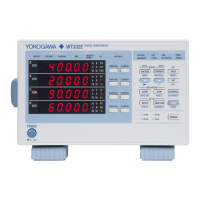App-11
IM WT310E-01EN
Appendix
App
Harmonics
Harmonics refer to all sine waves whose frequency is an integer multiple of the fundamental wave
(normallya50Hzor60Hzsinusoidalpowerlinesignal)exceptforthefundamentalwaveitself.The
input currents that flow through the power rectification circuits, phase control circuits, and other circuits
used in various kinds of electrical equipment generate harmonic currents and voltages in power lines.
When the fundamental wave and harmonic waves are combined, waveforms become distorted, and
interference sometimes occurs in equipment connected to the power line.
Terminology
The terminology related to harmonics is described below.
• Fundamentalwave(fundamentalcomponent)
The sine wave with the longest period among the different sine waves contained in a periodic
complex wave. Or the sine wave that has the fundamental frequency within the components of the
complex wave.
• Fundamentalfrequency
The frequency corresponding to the longest period in a periodic complex wave. The frequency of
the fundamental wave.
• Distorted wave
A wave that differs from the fundamental wave.
• Higher harmonic
A sine wave with a frequency that is an integer multiple (twice or more) of the fundamental
frequency.
• Harmoniccomponent
A waveform component with a frequency that is an integer multiple (twice or more) of the
fundamental frequency.
• Harmonicdistortionfactor
The ratio of the rms value of the specified nth order harmonic contained in the distorted wave to the
rms value of the fundamental wave (or all signals).
• Harmonicorder
The integer ratio of the harmonic frequency with respect to the fundamental frequency.
• Total harmonic distortion
The ratio of the rms value of all harmonics to the rms value of the fundamental wave (or all signals).
Interference Caused by Harmonics
Some of the effects of harmonics on electrical devices and equipment are explained in the list below.
• Synchronizationcapacitorsandseriesreactors
Harmonic current reduces circuit impedance. This causes excessive current flow, which can result
in vibration, humming, overheat, or burnout.
• Cables
Harmonic current flow through the neutral line of a three-phase, four-wire system will cause the
neutral line to overheat.
• Voltagetransformers
Harmonics cause magnetostrictive noise in the iron core and increase iron and copper loss.
• Breakersandfuses
Excessive harmonic current can cause erroneous operation and blow fuses.
• Communicationcables
The electromagnetic induction caused by harmonics creates noise voltage.
• Controldevices
Harmonic distortion of control signals can lead to erroneous operation.
• Audiovisualdevices
Harmonics can cause degradation of performance and service life, noise-related video flickering,
and damaged parts.
Appendix 2 Power Basics (Power, harmonics, and AC RLC circuits)

